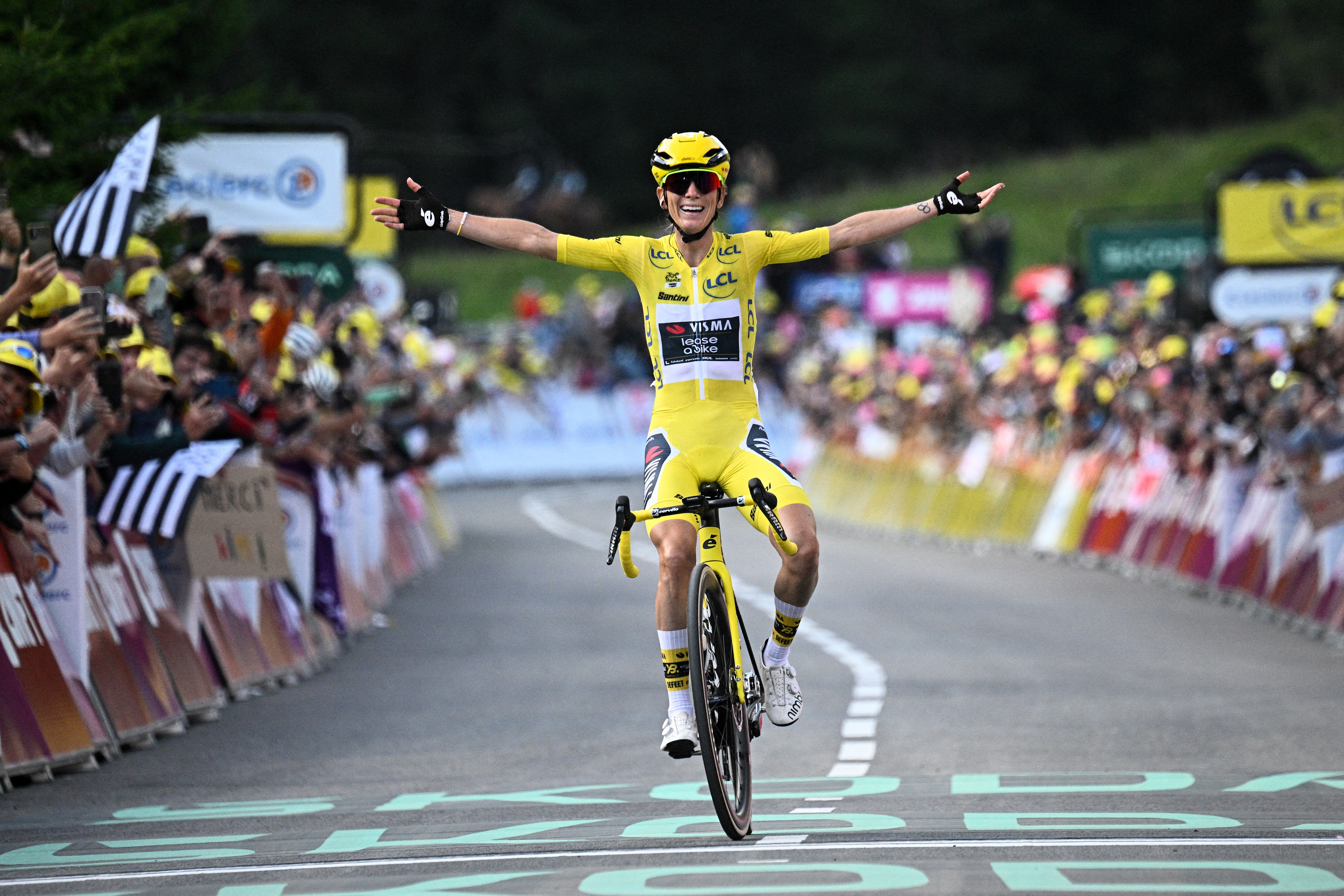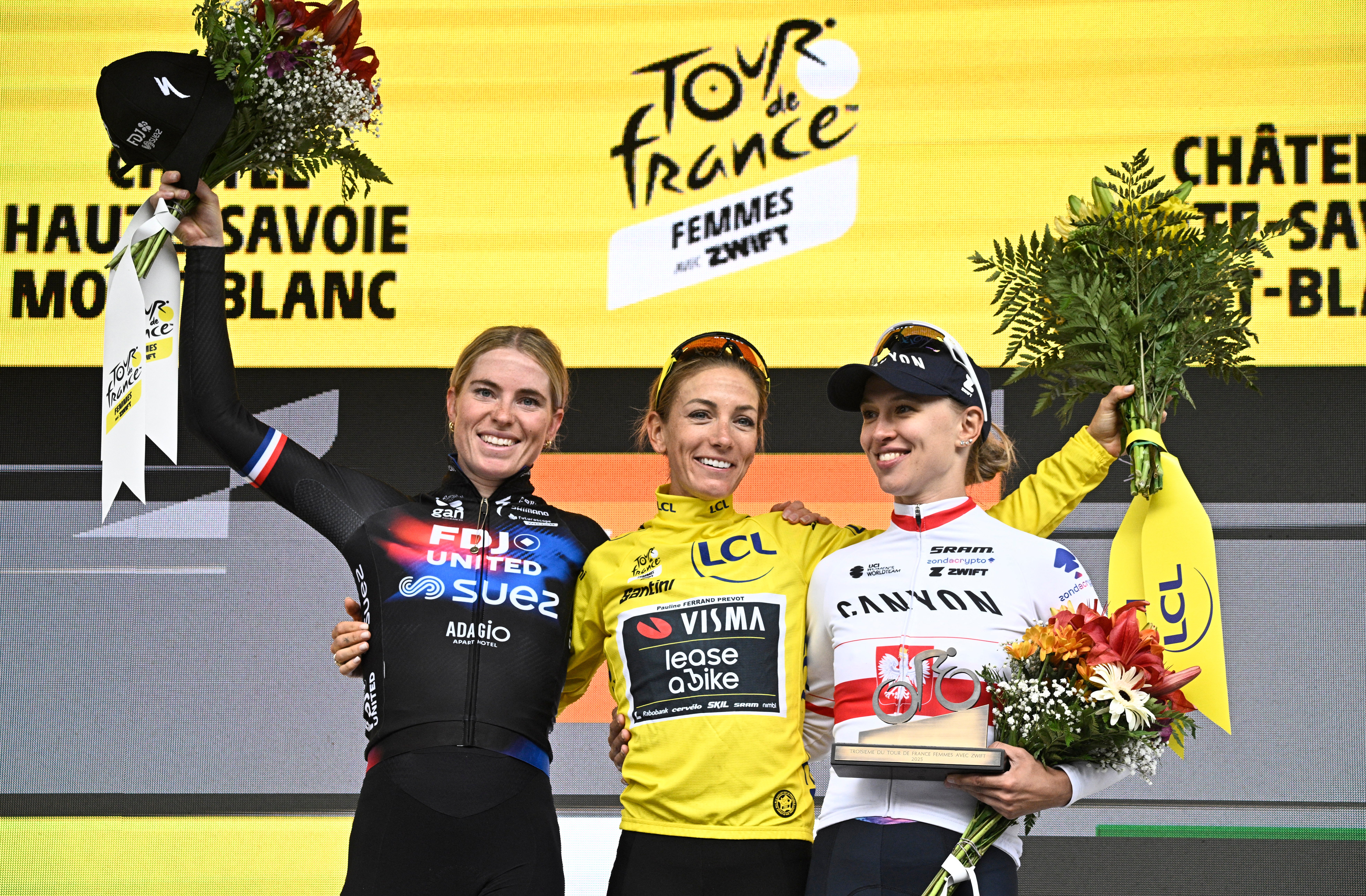Pauline Ferrand-Prevot has made history for France – and shown the way forward for women’s cycling

Forty long years have passed since a French rider won the Tour de France. Forty years of hand-wringing in L’Equipe and feverish tension every July. The great Bernard Hinault has endured a long wait for a successor.
As Pauline Ferrand-Prevot crossed the line in Chatel, soaking in the adulation of the crowd, 40 years of hurt came to an end. She held out her arms, slipped off her bike and lay flat on her back in the finish area, the weight of her achievement sinking in.
The 33-year-old’s palmares is among the most impressive in history, spanning nearly every discipline: a win on the cobbles of Paris-Roubaix earlier this year, 12 world titles, Olympic mountain bike gold, to name just a few standouts. But there was a sense that this one meant more than any other victory.
What seemed like a very bold statement at the time of her comeback to road racing after seven years away, that she wanted to win the Tour de France, now seems simply prophetic, a sign of the steely-eyed determination that delivered her to the title in her first season back.
“I’ve realised a little girl’s dream, it’s a perfect day,” Ferrand-Prévot said after taking yellow on stage eight. “I have to thank the public and my family who were here at the roadside.”
Her historic individual triumph has the potential to be much more than purely another glorious win for one of cycling’s serial winners. It could also change the course of women’s cycling.
A women’s version of the Tour de France has been run intermittently since 1955; a race known as the Tour de France Féminin was won three times by French great Jeannie Longo in the 1980s, while compatriot Catherine Marsal won its successor, the Tour de la C.E.E. Féminin, in 1990.
But a lack of stable, committed sponsorship and funding, indifferent media coverage, and either ambivalence or outright opposition from the Tour organisers meant the women’s Tour was always teetering on the verge of collapse.

Operating in such an atmosphere, it’s hardly surprising that the women’s Tour became a stunted, half-hearted thing in the 2000s. Britain’s Emma Pooley joked that the crisis-hit 2009 Grande Boucle Féminine Internationale, which she won, was more of a “Petite Boucle”. It shuttered that year.
Then came progress in the form of ASO finally agreeing to helm a women’s version. La Course, a one-, sometimes two-day race, was formed under pressure from a group of female campaigners, including Pooley and Marianne Vos. The race took place at the same time as the men’s and was entirely overshadowed by it.
Fast-forward only four years from the inception of the Tour de France Femmes – finally, a real, fully-fledged counterpart to les hommes – and the days of the petite Boucle and La Course feel very far away.
This is the final year that the women’s edition will directly follow, or clash with, the men’s race, taking an entirely separate slot in the calendar from 2026. “Our Tour is getting too big to be run at the same time as the men’s race,” race director Marion Rousse said. “We need to change the model and create our own timescale.”
Far from the patronising course design of previous incarnations of the Tour, which riders complained did not challenge them enough, the trend in recent years has been to make the race more difficult. In 2023 Demi Vollering wrote herself into the history books as a winner on the mist-shrouded slopes of the Col du Tourmalet; last year’s route finished on possibly the Tour’s most legendary climb, Alpe d’Huez. This year the race again reached a climax in the Alps, with Ferrand-Prevot winning on the Col de la Madeleine. Those proved the standout moments of each Tour; we can only hope next year’s route is even bigger and bolder.

The race had been talked up as the blockbuster rematch between last year’s champion Kasia Niewiadoma and 2023 winner Demi Vollering. While those two were deservedly on the podium at the end of the race – both for the fourth year in a row – this year’s edition was also notable for the breakthrough of several other challengers, as the women’s peloton continues to go from strength to strength.
Kim Le Court made history for Mauritius, becoming the first African rider to win a stage of the race and to wear yellow, while Australian Sarah Gigante proved herself a force to be reckoned with on the toughest climbs, and a potential GC contender if she can overcome her descending woes.
None of Lotte Kopecky, Marlen Reusser or Elisa Longo Borghini were at full strength for this race, with the latter two abandoning. If they had been fit we could have seen similar drama to last year’s race, when an unprecedented four-second gap separated yellow from second place. The margins for success in such a talented peloton are finer than ever.
For the home nation in particular, this is a moment to celebrate. French riders have won nearly half the stages in this race, the brilliant youngster Maeva Squiban and veteran Ferrand-Prevot taking two apiece.
Alongside the pair, the nation has a host of present and future stars in Cedrine Kerboal – winner of stage six last year, the first-ever French winner of a stage – Marion Bunel, Juliette Labous, and Evita Muzic. While France’s male cyclists struggle under the weight of history and the overbearing expectations of the public, its women have more than risen to the task.

Even a frustrated Vollering, second on the final stage and second overall to add to her heartbreaking second on the podium last year, could see the bigger picture. “Cycling is in a great place now, new riders coming up and coming back. It’s an exciting time,” she said. Jeannie Longo, watching from the roadside in Chatel, must have agreed.
What next for women’s cycling, and its biggest race? Perhaps to look forward, we have to look back: to Longo, Marsal, and the early blueprint for the Tour de France Femmes. The first Tour de France Féminin, won by American Marianne Martin, was 18 stages long; Longo’s triumphs were over 15, 12, and 11 stages, each with an additional prologue.
With the ever-increasing professionalisation of the women’s peloton, and its huge strength in depth, there is no reason why the Tour de France Femmes cannot reach the length of its 1980s counterpart. Could a race of true parity, a 21-stage race traversing every kind of terrain, with equal billing to the hommes, be on the cards?
Ferrand-Prevot’s victory is the perfect launchpad: for a new wave of enthusiasm in France for women’s cycling, and for taking this race to new heights.
As Ferrand-Prevot rode herself into yellow and sealed the race’s queen stage atop the infamous Col de la Madeleine, Rousse embraced her compatriot at the roadside. She later said, “I really felt something big was happening. I had tears in my eyes. I was a little overwhelmed because women’s cycling has come so far.” This race has proven just how much further it can go.
